- Home
- Robert Graves
The Greek Myths, Volume 1 Page 2
The Greek Myths, Volume 1 Read online
Page 2
The moon’s three phases of new, full, and old recalled the matriarch’s three phases of maiden, nymph (nubile woman), and crone. Then, since the sun’s annual course similarly recalled the rise and decline of her physical powers – spring a maiden, summer a nymph, winter a crone – the goddess became identified with seasonal changes in animal and plant life; and thus with Mother Earth who, at the beginning of the vegetative year, produces only leaves and buds, then flowers and fruits, and at last ceases to bear. She could later be conceived as yet another triad: the maiden of the upper air, the nymph of the earth or sea, the crone of the underworld – typified respectively by Selene, Aphrodite, and Hecate. These mystical analogues fostered the sacredness of the number three, and the Moon-goddess became enlarged to nine when each of the three persons – maiden, nymph, and crone – appeared in triad to demonstrate her divinity. Her devotees never quite forgot that there were not three goddesses, but one goddess; though, by Classical times, Arcadian Stymphalus was one of the few remaining shrines where they all bore the same name: Hera.
Once the relevance of coition to child-bearing had been officially admitted – an account of this turning-point in religion appears in the Hittite myth of simple-minded Appu (H. G. Güterbock: Kumarbi, 1946) – man’s religious status gradually improved, and winds or rivers were no longer given credit for impregnating women. The tribal Nymph, it seems, chose an annual lover from her entourage of young men, a king to be sacrificed when the year ended; making him a symbol of fertility, rather than the object of her erotic pleasure. His sprinkled blood served to fructify trees, crops, and flocks, and his flesh was torn and eaten raw by the Queen’s fellow-nymphs – priestesses wearing the masks of bitches, mares, or sows. Next, in amendment to this practice, the king died as soon as the power of the sun, with which he was identified, began to decline in the summer; and another young man, his twin, or supposed twin – a convenient ancient Irish term is ‘tanist’ – then became the Queen’s lover, to be duly sacrificed at midwinter and, as a reward, reincarnated in an oracular serpent. These consorts acquired executive power only when permitted to deputize for the Queen by wearing her magical robes. Thus kingship developed, and though the Sun became a symbol of male fertility once the king’s life had been identified with its seasonal course, it still remained under the Moon’s tutelage; as the king remained under the Queen’s tutelage, in theory at least, long after the matriarchal phase had been outgrown. Thus the witches of Thessaly, a conservative region, would threaten the Sun, in the Moon’s name, with being engulfed by perpetual night.
There is, however, no evidence that, even when women were sovereign in religious matters, men were denied fields in which they might act without female supervision, though it may well be that they adopted many of the ‘weaker-sex’ characteristics hitherto thought functionally peculiar to man. They could be trusted to hunt, fish, gather certain foods, mind flocks and herds, and help defend the tribal territory against intruders, so long as they did not transgress matriarchal law. Leaders of totem clans were chosen and certain powers awarded them, especially in times of migration or war. Rules for determining who should act as male commander-in-chief varied, it appears, in different matriarchies: usually the queen’s maternal uncle, or her brother, or the son of her maternal aunt was chosen. The most primitive tribal commander-in-chief also had authority to act as judge in personal disputes between men, in so far as the queen’s religious authority was not thereby impaired. The most primitive matrilineal society surviving today is that of the Nayars of Southern India, where the princesses, though married to child-husbands whom they immediately divorce, bear children to lovers of no particular rank; and the princesses of several matrilineal tribes of West Africa marry foreigners or commoners. The royal women of pre-Hellenic Greece also thought nothing of taking lovers from among their serfs, if the Hundred Houses of Locris and Epizephyrian Locri were not exceptional.
Time was first reckoned by lunations, and every important ceremony took place at a certain phase of the moon; the solstices and equinoxes not being exactly determined but approximated to the nearest new or full moon. The number seven acquired peculiar sanctity, because the king died at the seventh full moon after the shortest day. Even when, after careful astronomical observation, the solar year proved to have 364 days, with a few hours left over, it had to be divided into months – that is, moon-cycles – rather than into fractions of the solar cycle. These months later became what the English-speaking world still calls ‘common-law months’, each of twenty-eight days; which was a sacred number, in the sense that the moon could be worshipped as a woman, whose menstrual cycle is normally twenty-eight days, and that this is also the true period of the moon’s revolutions in terms of the sun. The seven-day week was a unit of the common-law month, the character of each day being deduced, it seems, from the quality attributed to the corresponding month of the sacred king’s life. This system led to a still closer identification of woman with moon and, since the 364-day year is exactly divisible by twenty-eight, the annual sequence of popular festivals could be geared to these common-law months. As a religious tradition, the thirteen-month years survived among European peasants for more than a millennium after the adoption of the Julian Calendar; thus Robin Hood, who lived at the time of Edward II, could exclaim in a ballad celebrating the May Day festival:
How many merry months be in the year?
There are thirteen, I say…
which a Tudor editor has altered to‘… There are but twelve, I say…’ Thirteen, the number of the sun’s death-month, has never lost its evil reputation among the superstitious. The days of the week lay under the charge of Titans: the genii of sun, moon, and the five hitherto discovered planets, who were responsible for them to the goddess as Creatrix. This system had probably been evolved in matriarchal Sumeria.
Thus the sun passed through thirteen monthly stages, beginning at the winter solstice when the days lengthen again after their long autumnal decline. The extra day of the sidereal year, gained from the solar year by the earth’s revolution around the sun’s orbit, was intercalated between the thirteenth and the first month, and became the most important day of the 365, the occasion on which the tribal Nymph chose the sacred king, usually the winner of a race, a wrestling match, or an archery contest. But this primitive calendar underwent modifications: in some regions the extra day seems to have been intercalated, not at the winter solstice, but at some other New Year – at the Candlemas cross-quarter day, when the first signs of spring are apparent; or at the spring equinox, when the sun is regarded as coming to maturity; or at midsummer; or at the rising of the Dog Star, when the Nile floods; or at the autumnal equinox, when the first rains fall.
Early Greek mythology is concerned, above all else, with the changing relations between the queen and her lovers, which begin with their yearly, or twice-yearly sacrifices; and end, at the time when the Iliad, was composed and kings boasted: ‘We are far better than our fathers!’, with her eclipse by an unlimited male monarchy. Numerous African analogues illustrate the progessive stages of this change.
A large part of Greek myth is politico-religious history. Bellerophon masters winged Pegasus and kills the Chimaera. Perseus, in a variant of the same legend, flies through the air and beheads Pegasus’s mother, the Gorgon Medusa; much as Marduk, a Babylonian hero, kills the she-monster Tiamat, Goddess of the Sea. Perseus’s name should properly be spelled Pterseus, ‘the destroyer’; and he was not, as Professor Kerenyi has suggested, an archetypal Death-figure but, probably, represented the patriarchal Hellenes who invaded Greece and Asia Minor early in the second millennium B.C., and challenged the power of the Triple-goddess. Pegasus had been sacred to her because the horse with its moon-shaped hooves figured in the rain-making ceremonies and the instalment of sacred kings; his wings were symbolical of a celestial nature, rather than speed. Jane Harrison has pointed out (Prolegomena to the Study of Greek Religion, chapter v) that Medusa was once the goddess herself, hiding behind a prophylactic Gorg
on mask: a hideous face intended to warn the profane against trespassing on her Mysteries. Perseus beheads Medusa: that is, the Hellenes overran the goddess’s chief shrines, stripped her priestesses of their Gorgon masks, and took possession of the sacred horses – an early representation of the goddess with a Gorgon’s head and a mare’s body has been found in Boeotia. Bellerophon, Perseus’s double, kills the Lycian Chimaera: that is, the Hellenes annulled the ancient Medusan calendar, and replaced it with another.
Again, Apollo’s destruction of the Python at Delphi seems to record the Achaeans’ capture of the Cretan Earth-goddess’s shrine; so does his attempted rape of Daphne, whom Hera thereupon metamorphosed into a laurel. This myth has been quoted by Freudian psychologists as symbolizing a girl’s instinctive horror of the sexual act; yet Daphne was anything but a frightened virgin. Her name is a contraction of Daphoene, ‘the bloody one’, the goddess in orgiastic mood, whose priestesses, the Maenads, chewed laurel-leaves as an intoxicant and periodically rushed out at the full moon, assaulted unwary travellers, and tore children or young animals in pieces; laurel contains cyanide of potassium. These Maenad colleges were suppressed by the Hellenes, and only the laurel grove testified to Daphoene’s former occupancy of the shrines: the chewing of laurel by anyone except the prophetic Pythian Priestess, whom Apollo retained in his service at Delphi, was tabooed in Greece until Roman times.
The Hellenic invasions of the early second millennium B.C., usually called the Aeolian and Ionian, seem to have been less destructive than the Achaean and Dorian ones, which they preceded. Small armed bands of herdsmen, worshipping the Aryan trinity of gods – Indra, Mitra, and Varuna – crossed the natural barrier of Mount Othrys, and attached themselves peacefully enough to the pre-Hellenic settlements in Thessaly and Central Greece. They were accepted as children of the local goddess, and provided her with sacred kings. Thus a male military aristocracy became reconciled to female theocracy, not only in Greece, but in Crete, where the Hellenes also gained a foothold and exported Cretan civilization to Athens and the Peloponnese. Greek was eventually spoken throughout the Aegean and, by the time of Herodotus, one oracle alone spoke a pre-Hellenic language (Herodotus: viii. 134–5). The king acted as the representative of Zeus, or Poseidon, or Apollo, and called himself by one or other of their names, though even Zeus was for centuries a mere demi-god, not an immortal Olympian deity. All early myths about the gods’ seduction of nymphs refer apparently to marriages between Hellenic chieftains and local Moon-priestesses; bitterly opposed by Hera, which means by conservative religious feeling.
When the shortness of the king’s reign proved irksome, it was agreed to prolong the thirteen-month year to a Great Year of one hundred lunations, in the last of which occurs a near-coincidence of solar and lunar time. But since the fields and crops still needed to be fructified, the king agreed to suffer an annual mock death and yield his sovereignty for one day – the intercalated one, lying outside the sacred sidereal year – to the surrogate boy-king, or interrex, who died at its close, and whose blood was used for the sprinkling ceremony. Now the sacred king either reigned for the entire period of a Great Year, with a tanist as his lieutenant; or the two reigned for alternate years; or the Queen let them divide the queendom into halves and reign concurrently. The king deputized for the Queen at many sacred functions, dressed in her robes, wore false breasts, borrowed her lunar axe as a symbol of power, and even took over from her the magical art of rain-making. His ritual death varied greatly in circumstance; he might be torn in pieces by wild women, transfixed with a sting-ray spear, felled with an axe, pricked in the heel with a poisoned arrow, flung over a cliff, burned to death on a pyre, drowned in a pool, or killed in a pre-arranged chariot crash. But die he must. A new stage was reached when animals came to be substituted for boys at the sacrificial altar, and the king refused death after his lengthened reign ended. Dividing the realm into three parts, and awarding one part to each of his successors, he would reign for another term; his excuse being that a closer approximation of solar and lunar time had now been found, namely nineteen years, or 325 lunations. The Great Year had become a Greater Year.
Throughout these successive stages, reflected in numerous myths, the sacred king continued to hold his position only by right of marriage to the tribal Nymph, who was chosen either as a result of a foot race between her companions of the royal house or by ultimogeniture – that is to say, by being the youngest nubile daughter of the junior branch. The throne remained matrilineal, as it theoretically did even in Egypt, and the sacred king and his tanist were therefore always chosen from outside the royal female house; until some daring king at last decided to commit incest with the heiress, who ranked as his daughter, and thus gain a new title to the throne when his reign needed renewal.
Achaean invasions of the thirteenth century B.C. seriously weakened the matrilineal tradition. It seems that the king now contrived to reign for the term of his natural life; and when the Dorians arrived, towards the close of the second millennium, patrilineal succession became the rule. A prince no longer left his father’s house and married a foreign princess; she came to him, as Odysseus persuaded Penelope to do. Genealogy became patrilineal, though a Samian incident mentioned in the Pseudo-Herodotus’s Life of Homer shows that for some time after the Apatoria, or Festival of Male Kinship, had replaced that of Female Kinship, the rites still consisted of sacrifices to the Mother Goddess which men were not eligible to attend.
The familiar Olympian system was then agreed upon as a compromise between Hellenic and pre-Hellenic views: a divine family of six gods and six goddesses, headed by the co-sovereigns Zeus and Hera and forming a Council of Gods in Babylonian style. But after a rebellion of the pre-Hellenic population, described in the Iliad as a conspiracy against Zeus, Hera became subservient to him. Athene avowed herself ‘all for the Father’ and, in the end, Dionysus assured male preponderance in the Council by displacing Hestia. Yet the goddesses, though left in a minority, were never altogether ousted – as they were at Jerusalem – because the revered poets Homer and Hesiod had ‘given the deities their titles and distinguished their several provinces and special powers’ (Herodotus: ii. 53), which could not be easily expropriated. Moreover, though the system of gathering all the women of royal blood together under the king’s control, and thus discouraging outsiders from attempts on a matrilineal throne, was adopted at Rome when the Vestal College was founded, and in Palestine when King David formed his royal harem, it never reached Greece. Patrilineal descent, succession, and inheritance discourage further myth-making; historical legend then begins and fades into the light of common history.
The lives of such characters as Heracles, Daedalus, Teiresias, and Phineus span several generations, because these are titles rather than names of particular heroes. Yet myths, though difficult to reconcile with chronology, are always practical: they insist on some point of tradition, however distorted the meaning may have become in the telling. Take, for instance, the confused story of Aeacus’s dream, where ants, falling from an oracular oak, turn into men and colonize the island of Aegina after Hera has depopulated it. Here the main points of interest are: that the oak had grown from a Dodonian acorn; that the ants were Thessalian ants; and that Aeacus was a grandson of the River Asopus. These elements combined to give a concise account of immigrations into Aegina towards the end of the second millennium B.C.
Despite a sameness of pattern in Greek myths, all detailed interpretations of particular legends are open to question until archaeologists can provide a more exact tabulation of tribal movements in Greece, and their dates. Yet the historical and anthropological approach is the only reasonable one: the theory that Chimaera, Sphinx, Gorgon, Centaurs, Satyrs and the like are blind uprushes of the Jungian collective unconscious, to which no precise meaning had ever, or could ever, have been attached, is demonstrably unsound. The Bronze and early Iron Ages in Greece were not the childhood of mankind, as Dr Jung suggests. That Zeus swallowed Metis, for instance, and subseque
ntly gave birth to Athene, through an orifice in his head, is not an irrepressible fancy, but an ingenious theological dogma which embodies at least three conflicting views:
(1) Athene was the parthenogenous daughter of Metis; i.e. the youngest person of the Triad headed by Metis, Goddess of Wisdom.
(2) Zeus swallowed Metis; i.e. the Achaeans suppressed her cult and arrogated all wisdom to Zeus as their patriarchal god.
(3) Athene was the daughter of Zeus; i.e. the Zeus-worshipping Achaeans spared Athene’s temples on condition that her votaries accepted his paramount sovereignty.
Zeus’s swallowing of Metis, with its sequel, will have been represented graphically on the walls of a temple; and as the erotic Dionysus – once a parthenogenous son of Semele – was reborn from his thigh, so the intellectual Athene was reborn from his head.

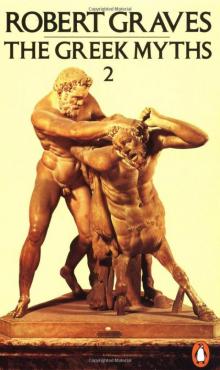 The Greek Myths, Volume2
The Greek Myths, Volume2 The Anger of Achilles: Homer's Iliad
The Anger of Achilles: Homer's Iliad Count Belisarius
Count Belisarius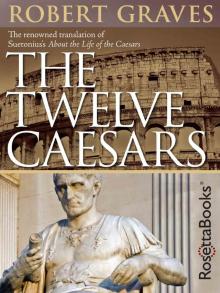 The Twelve Caesars
The Twelve Caesars Complete Poems 3 (Robert Graves Programme)
Complete Poems 3 (Robert Graves Programme) Homer's Daughter
Homer's Daughter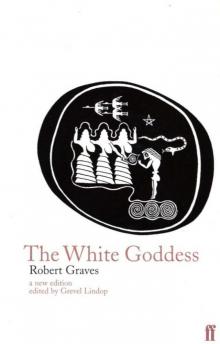 The White Goddess
The White Goddess Goodbye to All That
Goodbye to All That Claudius the God and His Wife Messalina
Claudius the God and His Wife Messalina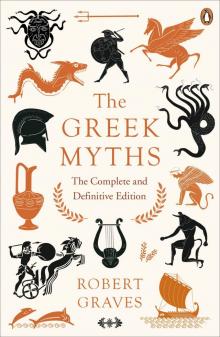 The Greek Myths
The Greek Myths I, Claudius
I, Claudius The Islands of Unwisdom
The Islands of Unwisdom Complete Short Stories
Complete Short Stories The Golden Fleece
The Golden Fleece They Hanged My Saintly Billy
They Hanged My Saintly Billy King Jesus
King Jesus Sergeant Lamb's America
Sergeant Lamb's America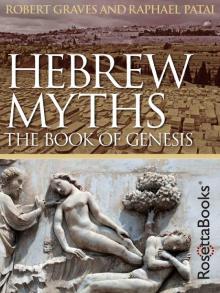 Hebrew Myths: The Book of Genesis
Hebrew Myths: The Book of Genesis Seven Days in New Crete
Seven Days in New Crete Proceed, Sergeant Lamb
Proceed, Sergeant Lamb Claudius the God
Claudius the God Wife to Mr. Milton
Wife to Mr. Milton The Complete Poems
The Complete Poems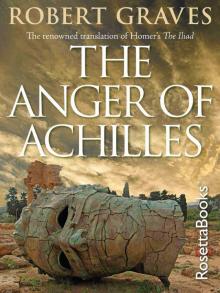 The Anger of Achilles
The Anger of Achilles Claudius the God c-2
Claudius the God c-2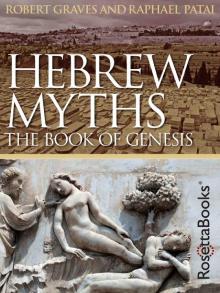 Hebrew Myths
Hebrew Myths I, Claudius c-1
I, Claudius c-1 The Greek Myths, Volume 1
The Greek Myths, Volume 1